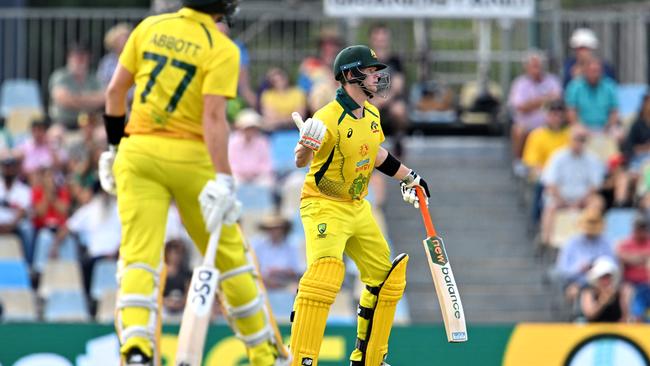Smith’s antics highlight umpires’ diminishing powers
Not content with being one of the best batsmen in the world, Steve Smith was intent on officiating a moment in the game as well.

During the one-day international in Cairns between Australia and New Zealand, Steve Smith gave a vivid illustration of how the relationship between players and umpires has changed in recent years.
Not content with being one of the best batsmen in the world, Smith was intent on officiating a moment in the game as well.
Just before facing a ball from Jimmy Neesham, Smith had realised that New Zealand had one too few fielders inside the inner circle, contrary to the regulations. Confident, therefore, that he could not be given out, Smith aimed a mighty heave to the leg side, throwing all caution to the wind. He middled the ball and it sailed into the crowd for six.
Rather than wait for the umpire to signal a no-ball, as surely would have been the case a generation ago, Smith started signalling a free hit of his own accord the moment the ball left the bat, by circling his arm frantically above his head. He then strode towards the square-leg umpire, pointing at each of the fielders who were outside the inner circle. In effect, he called the free hit himself.
Smith is no stranger to these kind of antics. When he was batting at the SCG during the Ashes last year, he set off for the pavilion at the merest hint of rain, despite the determination of the umpires to stay on. Towards the dying stages of the game, when Stuart Broad and James Anderson were batting out for the draw and Smith was bowling leg-spin because of bad light, a sprinkle of juice from the skies brought forth no such swift retreat.
This kind of carry-on is anathema to players of a previous generation who, while occasionally in moments of exasperation could be found guilty of obvious dissent, generally accepted the distance in authority between them and umpires. The umpires ran the game; their decisions were final and players, by and large, abided by them, even if they grumbled frequently about injustice and fairness.
Stories abound of players chafing at authority from time to time. At the Oval last week was Chris Broad, who famously had to be pulled away from the crease by Graham Gooch in Pakistan in 1987. On that tour, a full day of Test cricket was abandoned – the most recent instance before the death of the Queen that England lost a day to anything other than weather – because of the stand-off between the umpire, Shakoor Rana, and Mike Gatting, the England captain. But these instances were rare.
The Decision Review System (DRS) has fundamentally altered the perception of umpires’ authority, though. With three reviews per innings in a Test match, scarcely a decision is made without incurring debate by players. In essence, this has worked well at international level: fewer mistakes are made and the relationships between players, which would occasionally flare up in the past out of frustration, have improved.
Neutral umpires, improved standards of umpiring and DRS have led to a more harmonious game, with better decision-making. Below international cricket, the picture is not quite so clear, as Lancashire’s response on Tuesday to a six-point deduction in the County Championship suggested.
To summarise briefly: Lancashire was under a suspended sentence for previous misdemeanours; two further instances this season of what umpires took to be dissent brought a six-point penalty, reduced because of the minor nature of the infractions. And they were minor: the players involved left the crease immediately upon being given out, albeit having shown some surprise at the decisions.
Lancashire’s response was robust, at once accepting the punishment while disputing its fairness. Beyond narrow self-interest, the club made some interesting points, in particular around the relationship between players and umpires which, it suggested, is not helped by the latter making snap judgments on penalties.
“Everyone would benefit from taking a breath” which would allow “umpires to build working relationships with players” as opposed to handing down punishments “which only creates tension”, Mark Chilton, the club’s director of cricket, said. I would agree with that point. My playing experience suggested that the best umpires combined good decision-making with a calm, rather than officious, manner. David Shepherd from my own generation was a great example; Marais Erasmus, more recently, another. Good umpires defuse situations rather than inflame them, which is more difficult if they have to impose sanctions almost immediately.
But, in essence, Lancashire’s response highlights how technology has outstripped decision-making, which relies solely on the human touch below international level. Last year, for example, when Smith and his protege Marnus Labuschagne were criticised mildly in the Australian press for lingering at the crease too long, it was in the Sheffield Shield.
At domestic level there is no recourse to technology and reviews. Set against that, every ball of every county game is streamed. Players have the ability to watch, over and over again, each ball they face and each ball they deliver. It is not difficult to see how that disparity between technological advance and human fallibility will have consequences around player reactions in an era when DRS has chipped away at umpiring authority.
A generation ago, a batsman might have walked into a dressing-room and complained about a decision. His teammates might have nodded out of goodwill (”there he goes, complaining again!”) and said some placating words, but there was no evidence to hand and the matter would be forgotten. Now, said batsman probably replays the decision over and over again to his colleagues on a laptop, so that the perceived injustice is registered, festering and lingering.
Professionals are less willing now to accept decisions with the equanimity that players of previous generations were forced to show. This shift in attitude reflects all kinds of changes: technological, mainly, but also that professional sport (not just cricket) is less accepting of the role of luck and human error.
Previously, luck – both good and bad – was seen as being part and parcel of the game (“it will even out in the end,” was often heard, even though when those bits of luck came your way could be the difference between a long run in the team or not). Not now, regrettably.
Umpires are no longer seen as the sole dispensers of justice, as they once were. Once upon a time, Jack Fingleton, the fine former Australian cricketer-turned-journalist, could write, only partly in jest, that umpires were more powerful than politicians, able to turn nations to ecstasy or grief with a twitch of the index finger.
Those words could not be written today.
The Times



